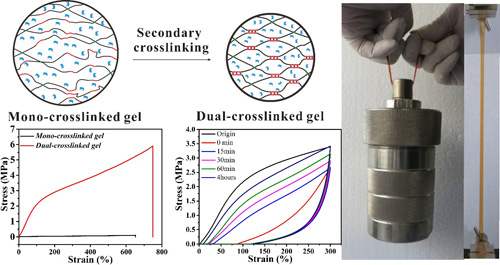| News |
| ・Events |
| ・Int’l Cooperation News |
| ・Upcoming Events |
| Location: Home>News>Events |
| LICP Designs Hdrogels with Extraordinary Mechanical Properties and Good Self-recovery |
| ||||||
|
|
The group headed by Professor ZHOU Feng from the Lanzhou Institute of Chemical Physics of the Chinese Academy of Sciences has designed and synthesized a molecularly engineered dual-crosslinked hydrogel with extraordinary mechanical properties. Hydrogels are widely studied “soft and wet” materials and have been widely applied in sensing, drug delivery, actuation, tissue engineering, etc. Hydrogels also possess a degree of flexibility very similar to natural tissue, which make them the ideal alternate materials for artificial joints and best substrate materials for the development of muscle-like actuators.
However, hydrogels usually do not have enough mechanical strength due to its intrinsic structural inhomogeneity or lacking of effective energy dissipation mechanism. Besides ultrahigh strength, good self-recovery property of a hydrogel at room temperature is also important for fatigue resistance and extending its service life. But, the reported hydrogels do not have self-recovery property or their self-recovery takes a long time. The novel dual-crosslinked hydrogel synthesized by ZHOU’s group combines both covalent crosslinking and multivalency ion pairing of Fe3+–acrylic acid coordination. The ion paring interaction acts as the special dynamic junction, when the external loading was applied, the coordination bond serves as the reversible sacrificial bonds and rupture to dissipate energies. Based on the function mechanism, ultrahigh mechanical strength, excellent elongation, and good self-recovery property were achieved. The optimal hydrogel achieves a tensile stress of ca.6 MPa at a large elongation ratio (>7 times), a toughness of 27 MJm−3, and a stiffness of ca.2 MPa, and has good self-recovery properties. Moreover, the mechanical property of the hydrogel can be easily tuned within a wide range for different applications by varying the concentration of acrylic acid or Fe3+-loading solution and so the number of ionic interaction. The synthetic method is very simple, and the raw materials are cheap and suitable for a large-scale preparation. The work has been published in Advanced Materials( 2015, 27(12), 2054-2059). The study was supported by the grant from National Science Foundation of China (Grant Nos. 20434009 and 21125316) and Key Research Program of CAS (KJZD-EW-M01).
Key words: hydrogels; dual-crosslinking; ultrahigh strength; self-recovery Contact: ZHOU Feng State Key Laboratory of Solid Lubrication, Lanzhou Institute of Chemical Physics, Chinese Academy of Sciences Email:zhouf@licp.cas.cn |
